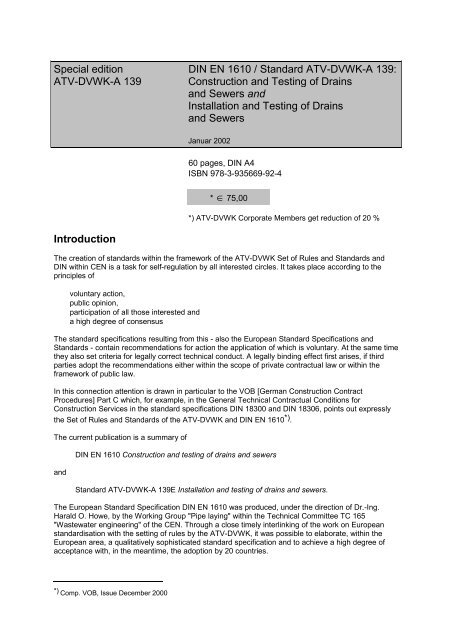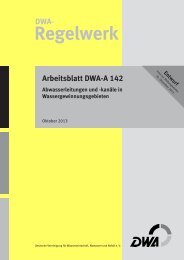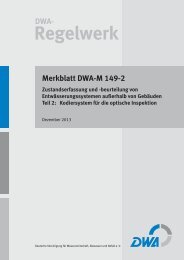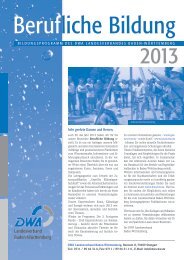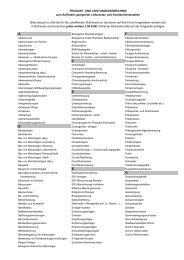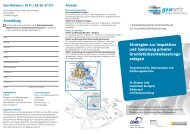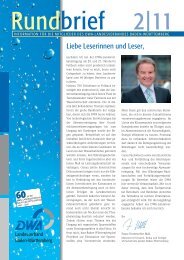Special edition DIN EN 1610 / Standard ATV-DVWK-A 139 ... - DWA
Special edition DIN EN 1610 / Standard ATV-DVWK-A 139 ... - DWA
Special edition DIN EN 1610 / Standard ATV-DVWK-A 139 ... - DWA
Create successful ePaper yourself
Turn your PDF publications into a flip-book with our unique Google optimized e-Paper software.
<strong>Special</strong> <strong>edition</strong> <strong>DIN</strong> <strong>EN</strong> <strong>1610</strong> / <strong>Standard</strong> <strong>ATV</strong>-<strong>DVWK</strong>-A <strong>139</strong>:<br />
<strong>ATV</strong>-<strong>DVWK</strong>-A <strong>139</strong> Construction and Testing of Drains<br />
and Sewers and<br />
Installation and Testing of Drains<br />
and Sewers<br />
Introduction<br />
Januar 2002<br />
60 pages, <strong>DIN</strong> A4<br />
ISBN 978-3-935669-92-4<br />
* 75,00<br />
*) <strong>ATV</strong>-<strong>DVWK</strong> Corporate Members get reduction of 20 %<br />
The creation of standards within the framework of the <strong>ATV</strong>-<strong>DVWK</strong> Set of Rules and <strong>Standard</strong>s and<br />
<strong>DIN</strong> within C<strong>EN</strong> is a task for self-regulation by all interested circles. It takes place according to the<br />
principles of<br />
voluntary action,<br />
public opinion,<br />
participation of all those interested and<br />
a high degree of consensus<br />
The standard specifications resulting from this - also the European <strong>Standard</strong> Specifications and<br />
<strong>Standard</strong>s - contain recommendations for action the application of which is voluntary. At the same time<br />
they also set criteria for legally correct technical conduct. A legally binding effect first arises, if third<br />
parties adopt the recommendations either within the scope of private contractual law or within the<br />
framework of public law.<br />
In this connection attention is drawn in particular to the VOB [German Construction Contract<br />
Procedures] Part C which, for example, in the General Technical Contractual Conditions for<br />
Construction Services in the standard specifications <strong>DIN</strong> 18300 and <strong>DIN</strong> 18306, points out expressly<br />
the Set of Rules and <strong>Standard</strong>s of the <strong>ATV</strong>-<strong>DVWK</strong> and <strong>DIN</strong> <strong>EN</strong> <strong>1610</strong> *) .<br />
The current publication is a summary of<br />
and<br />
<strong>DIN</strong> <strong>EN</strong> <strong>1610</strong> Construction and testing of drains and sewers<br />
<strong>Standard</strong> <strong>ATV</strong>-<strong>DVWK</strong>-A <strong>139</strong>E Installation and testing of drains and sewers.<br />
The European <strong>Standard</strong> Specification <strong>DIN</strong> <strong>EN</strong> <strong>1610</strong> was produced, under the direction of Dr.-Ing.<br />
Harald O. Howe, by the Working Group "Pipe laying" within the Technical Committee TC 165<br />
"Wastewater engineering" of the C<strong>EN</strong>. Through a close timely interlinking of the work on European<br />
standardisation with the setting of rules by the <strong>ATV</strong>-<strong>DVWK</strong>, it was possible to elaborate, within the<br />
European area, a qualitatively sophisticated standard specification and to achieve a high degree of<br />
acceptance with, in the meantime, the adoption by 20 countries.<br />
*) Comp. VOB, Issue December 2000
<strong>DIN</strong> <strong>EN</strong> <strong>1610</strong>, which has been valid since October 1997, describes the European standard for the<br />
laying and testing of drains and sewers outside buildings. In the new <strong>edition</strong> of the <strong>ATV</strong>-<strong>DVWK</strong><br />
<strong>Standard</strong> <strong>ATV</strong>-<strong>DVWK</strong>-A <strong>139</strong>E, supplementary information and more detailed statements on <strong>DIN</strong> <strong>EN</strong><br />
<strong>1610</strong> are described which, from the point of view of those experts involved, are considered to be<br />
necessary remarks and which are expressly intended in <strong>DIN</strong> <strong>EN</strong> <strong>1610</strong>. In this respect the <strong>Standard</strong><br />
<strong>ATV</strong>-<strong>DVWK</strong>-A <strong>139</strong>E is to be taken as the national supplement to <strong>DIN</strong> <strong>EN</strong> <strong>1610</strong>. The elaboration was<br />
undertaken, under the leadership of Dipl.-Ing. Dieter Sternagel, by the <strong>ATV</strong>-<strong>DVWK</strong>-Working Group<br />
"General principles for the construction of drainage systems" within the <strong>ATV</strong>-<strong>DVWK</strong> Main Committee<br />
"Drainage systems".<br />
The <strong>Standard</strong> applies for the production and testing of earth-covered drains and sewers placed in<br />
open cut trenches and above ground outside buildings. With this, the planning engineer is given an aid<br />
which is to be recognised and utilised within the scope presented in <strong>DIN</strong> <strong>EN</strong> <strong>1610</strong>. The supplements<br />
and notes refer to the placing of pipes, their testing, to the materials to be used and to the acceptance<br />
procedure for the structure. Attention is drawn particularly in that the requirements placed on the<br />
qualification of the implementing firm are also to be described, which in the same manner also apply in<br />
other countries.<br />
Through the joint application of <strong>DIN</strong> <strong>EN</strong> <strong>1610</strong> and <strong>Standard</strong> <strong>ATV</strong>-<strong>DVWK</strong>-A <strong>139</strong>E a qualitatively high<br />
standard implementation of construction will be achieved. The technically correct production of sewers<br />
and drains, together with the use of suitable and reliable materials, is the prerequisite for a long-term<br />
functioning, economic and groundwater-protective sewer network.<br />
Note:<br />
This publication includes <strong>DIN</strong> <strong>EN</strong> <strong>1610</strong> and <strong>Standard</strong> <strong>ATV</strong>-<strong>DVWK</strong>-A <strong>139</strong>E each in the original<br />
text. The passages originating from <strong>ATV</strong>-<strong>DVWK</strong>-A <strong>139</strong>E are underlayed in blue.<br />
Foreword<br />
This European <strong>Standard</strong> was approved by C<strong>EN</strong> on 1997-05-18.<br />
C<strong>EN</strong> members are bound to comply with the C<strong>EN</strong>/C<strong>EN</strong>ELEC Internal Regulations<br />
which stipulate the conditions for giving this European <strong>Standard</strong> the status of a<br />
national standard without any alteration. Up-to-date lists and bibliographical<br />
references concerning such national standards may be obtained on application to the<br />
Central Secretariat or to any C<strong>EN</strong> member.<br />
The European <strong>Standard</strong>s exist in three official versions (English, French, German).<br />
A version in any other language made by translation under the responsibility of a<br />
C<strong>EN</strong> member into its own language and notified to the Central Secretariat has the<br />
same status as the official versions.<br />
C<strong>EN</strong> members are the national standards bodies of Austria, Belgium, the Czech Republic, Denmark,<br />
Finland, France, Germany, Greece, Iceland, Ireland, Italy, Luxembourg, the Netherlands, Norway,<br />
Portugal, Spain, Sweden, Switzerland, and the United Kingdom.<br />
This European <strong>Standard</strong> has been prepared by Technical Committee C<strong>EN</strong>TC 165 "Waste water<br />
engineering", the secretariat of which is held by <strong>DIN</strong>.<br />
This European <strong>Standard</strong> shall be given the status of a national standard, either by<br />
publication of an identical text or by endorsement, at the latest by March 1998, and<br />
conflicting national standards shall be withdrawn at the latest by March 1998.
Annexes A, B and C are informative.<br />
According to the C<strong>EN</strong>/C<strong>EN</strong>ELEC Internal Regulations, the national standards<br />
organizations of the following countries are bound to implement this European<br />
<strong>Standard</strong>:Austria, Belgium, Czech Republic, Denmark, Finland, France, Germany,<br />
Greece, Iceland, Ireland, Italy, Luxembourg, Netherlands, Norway, Portugal, Spain,<br />
Sweden, Switzerland and the United Kingdom.<br />
This standard has been prepared by C<strong>EN</strong>/TC 165.<br />
The responsible German body involved in its preparation was the Normenausschuß<br />
Wasserwesen (Water Practice <strong>Standard</strong>s Committee), Technical Committee<br />
Rohrverlegung/Rohrstatik.<br />
Amendments<br />
<strong>DIN</strong> 4033, November 1979 <strong>edition</strong>, has been superseded by the specifications of <strong>EN</strong><br />
<strong>1610</strong>.<br />
Previous <strong>edition</strong>s<br />
<strong>DIN</strong> 4033: 1940-04, 1941-05, 1963-05, 1979-11.<br />
The new <strong>edition</strong> of <strong>ATV</strong>-<strong>DVWK</strong> <strong>Standard</strong> A-<strong>139</strong>E presented here contains the<br />
supplementary information and more extensive comments on <strong>DIN</strong> <strong>EN</strong> <strong>1610</strong>, which<br />
are held to be necessary by the specialist circles involved.<br />
Prerequisite for a long-term functional and watertight sewer network is, in addition to<br />
the employment of suitable and resistant materials, above all, the correct production<br />
of the sewers and drains.<br />
The solution to be sought is an overall economically optimised solution. In addition to<br />
investment costs the operating costs and the service life are to be taken into account.<br />
The recycling of the components and materials used should be considered in the<br />
planning.<br />
Based on the Mandate of the Commission of the European Community and, equally,<br />
on that of EFTA dated 24 May 1991, C<strong>EN</strong> (Comité Européen de Normalisation) has<br />
taken on the task of aligning all technical rules within the field of wastewater<br />
technology and of elaborating European <strong>Standard</strong> Specifications for the defined<br />
areas and products. In the meantime these tasks have very extensively been<br />
completed with the inclusion of the technical rules for the laying and testing of drains<br />
and sewers outside buildings.<br />
In Germany, in addition to <strong>DIN</strong> 4033, <strong>Standard</strong> <strong>ATV</strong>-A <strong>139</strong>E ”Installation and Testing<br />
of Drains and Sewers” (October 1988 Edition) were available for this and were<br />
introduced as a basis for discussion within the framework of the work of the<br />
responsible C<strong>EN</strong> Technical Committee, TC 165 - Wastewater Technology, hereafter<br />
WG 10/TG2. The result of the work at C<strong>EN</strong> level consists of the accepted and, in<br />
Germany, as <strong>DIN</strong> <strong>EN</strong> <strong>Standard</strong> Specification converted document <strong>DIN</strong> <strong>EN</strong> <strong>1610</strong><br />
”Construction and testing of drains and sewers” (October 1997), the contents of<br />
which thus describes the generally recognised status of technology in Europe.
As a supplement, it is possible to formulate statements which are not or not<br />
completely contained in European standards, in order to cover the necessary<br />
national contents.<br />
<strong>DIN</strong> <strong>EN</strong> <strong>1610</strong> ”Construction and testing of sewers and drains” lays down<br />
requirements on the correct production and testing of drains and sewers.<br />
The <strong>Standard</strong> presented here is to aid the planning engineer in recognising the<br />
existing leeway present in <strong>DIN</strong> <strong>EN</strong> <strong>1610</strong> and to use it creatively. It is to ease the<br />
utilisation and interpretation in <strong>DIN</strong> <strong>EN</strong> <strong>1610</strong>.<br />
The <strong>Standard</strong> contains supplements and notes for the installation of pipes, their<br />
testing, on materials used as well as the acceptance of the structure. The<br />
requirements on qualification of the executing firm are equally defined.<br />
In order to ensure uniformity of text, some repeating of the text of statements from<br />
<strong>DIN</strong> <strong>EN</strong> <strong>1610</strong> is necessary.<br />
Appendices A and B contain requirements on model installation instructions as well<br />
as information on economic aspects.<br />
Publisher<br />
This <strong>ATV</strong> <strong>Standard</strong> has been elaborated by the <strong>ATV</strong>-<strong>DVWK</strong> Working Group ES-5.1<br />
”General Guidelines for the Construction of Drainage Systems” within the <strong>ATV</strong>-<br />
<strong>DVWK</strong> <strong>Special</strong>ist Committee ES-5 ”Design of Drainage Systems”.<br />
Working Group ES-5.1 has the following members:<br />
Dipl.-Ing. Horst Adler, Köln<br />
Dipl.-Ing. Ralf Bosse, München<br />
Dipl.-Ing. Peter Brune, Gelsenkirchen<br />
Dipl.-Ing. Uwe Dickmanns, Coesfeld<br />
Dipl.-Ing. Karl-Heinz Flick, Köln<br />
Dr.-Ing. Helmuth Friede, Bad Honnef<br />
Bau-Techn. Heinz Herz, Kehl<br />
Dr.-Ing. Karl Hornung, Stuttgart<br />
Dipl.-Ing. Karsten Körkemeyer, Bochum<br />
Dipl.-Ing. Ulrich Kusche, Niemetal-Imbsen<br />
Dipl.-Ing. Peter Lutz, Kehl<br />
Dipl.-Ing. Werner Neubauer, Köln<br />
Dipl.-Ing. Gerd Niedrée, Bonn<br />
Dipl.-Geol. Andreas Paetz, Berlin<br />
Dipl.-Ing. Hans-Joachim Purde, Baldham<br />
Dipl.-Ing. Franz Rapp, Regensburg<br />
Dipl.-Ing. Wolfgang Rieger, München<br />
Dipl.-Ing. Helmut Schgeiner, Berlin<br />
Dr.-Ing. Rolf Schlichting, Aurich<br />
Dipl.-Ing. Jürgen Schulte, Pulheim
Dipl.-Ing. Helmut Stecha, Wiesbaden<br />
Ltd. BD Dipl.-Ing. Dieter Sternagel, Kassel (Chairman)<br />
Dipl.-Ing. Dieter Wengler, Rheinfelden


